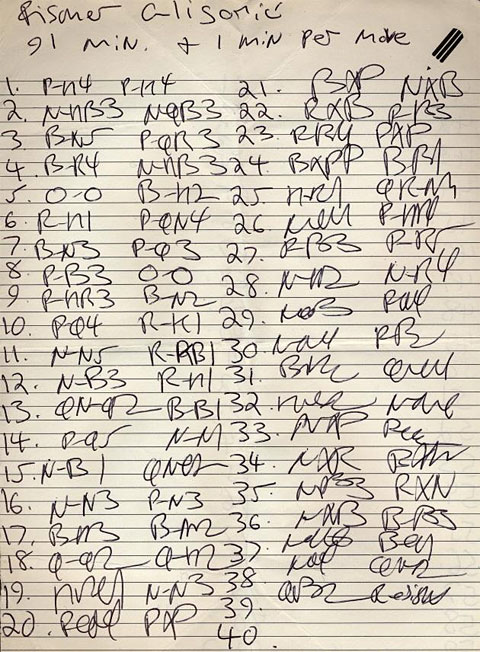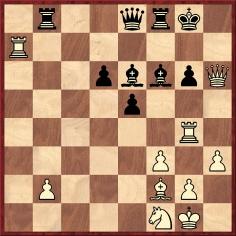


Pages 180-181 of Bobby Fischer Uncensored by David DeLucia (Darien, 2009) gave three training games played by Fischer and Gligorić, and page 332 of volume two of Mr DeLucia’s new work In Memoriam has another game-score, with the caption ‘Unrecorded training game, Fischer-Gligoric 1992, written in Fischer’s hand’. With the author’s permission C.N. 7542 reproduced the score-sheet:

C.N. 7543 reported that two attempts to unravel the moves had been received from C.N. readers.
1) From Eduardo Bauzá Mercére (New York, NY, USA):
1 e4 e5 2 Nf3 Nc6 3 Bb5 a6 4 Ba4 Nf6 5 O-O Be7 6 Re1 b5 7 Bb3 d6 8 c3 O-O 9 h3 Bb7 10 d4 Re8 11 Ng5 Rf8 12 Nf3 Re8 13 Nbd2 Bf8 14 d5 Nb8 15 Nf1 Nbd7 16 Ng3 g6 17 Be3 Bg7 18 Qd2 Qe7 19 Nh2 Nb6 20 a4 bxa4 21 Bxa4 Nxa4 22 Rxa4 c6 23 c4 cxd5 24 cxd5 Bc8 25 Rea1 Rb8 26 R1a2 h5 27 f3 h4 28 Ne2 Nh5 29 R4a3 f5 30 Ra4 Rf8 31 Bf2 Qf7 32 Nf1 fxe4 33 Rxe4 Nf6 34 Rxh4 Bb7 35 Nc3 Nxd5 36 Nxd5 Bxd5 37 Rxa6 Bf6 38 Rg4 Be6 39 Ra7 Qe8 40 Qh6 Resigns.

2) From Luc Winants (Boirs, Belgium):
1 e4 e5 2 Nf3 Nc6 3 Bb5 a6 4 Ba4 Nf6 5 O-O Be7 6 Re1 b5 7 Bb3 d6 8 c3 O-O 9 h3 Bb7 10 d4 Re8 11 Ng5 Rf8 12 Nf3 Re8 13 Nbd2 Bf8 14 d5 Nb8 15 Nf1 Nbd7 16 Ng3 g6 17 Be3 Bg7 18 Qd2 Qe7 19 Rf1 Nb6 20 a4 bxa4 21 Bxa4 Nxa4 22 Rxa4 c6 23 c4 cxd5 24 cxd5 Bc8 25 Rfa1 Rb8 26 Ne1 h5 27 f3 h4 28 Ne2 Nh5 29 Nd3 f5 30 Nb4 f4 31 Bf2 Qg5 32 Kh2 Ng3 33 Nxa6 Bd7 34 Nxb8 Bxa4 35 Nc3 Rxb8 36 Nxa4 Bf6 37 Nb6 Bd8 38 Nc4 Qe7 39 Qc2 Resigns.

Subsequently (C.N. 7552) Mr Bauzá Mercére wrote to us:
‘In Mr Winants’ reconstruction there are many moves which, with hindsight, I find more recognizable from the original score-sheet than in my own attempt. For example: 29 NQ3, 31...QN5, 32...NN6, 34 NxR, 35 NB3! (and not 35 Rxa4 Nf1+), and 39 QB2. Even the mysterious rook move 19 Rf1 would match the apparent 19 RB1.
So I think that, short of obtaining from Gligorić himself a different version of the game, Mr Winants’ reconstruction should be taken as the true score. My congratulations to him.’
Mr Bauza Mercére later made a further comparison of Fischer’s handwriting in the context of move 19 and felt that 19 RKQ1 may be more likely:

We also received an additional contribution from Mr Winants:
‘The 19th move was one moment of doubt because what I read on the score-sheet was KR-e1 instead of KR-B1. However, Rf1 is a very common move in such variations of the Ruy López. Among the many examples are:
I took 19 Rf1 because it is a common move, but 19 Red1, to stop c7-c6, seems very logical as well and perhaps even more appropriate to the situation. Even 19 Rec1 (to support c3-c4) has its points.
I had other doubts later on, but after I reached the position following 34...Bxa4, when 35 Rxa4 is refuted by 35...Nf1+ and 35 Nc6 by 35...Bb5, I thought that this was most probably the correct version.
It would be very interesting to know the opinion of more grandmasters.’
And that is how the matter currently stands. Can any improvements to the reconstruction still be made?

Submit information or suggestions on chess explorations
All ChessBase articles by Edward Winter

Edward Winter is the editor of Chess Notes, which was founded in January 1982 as "a forum for aficionados to discuss all matters relating to the Royal Pastime". Since then, over 7,550 items have been published, and the series has resulted in four books by Winter: Chess Explorations (1996), Kings, Commoners and Knaves (1999), A Chess Omnibus (2003) and Chess Facts and Fables (2006). He is also the author of a monograph on Capablanca (1989). In 2011 a paperback edition was issued.
Chess Notes is well known for its historical research, and anyone browsing in its archives will find a wealth of unknown games, accounts of historical mysteries, quotes and quips, and other material of every kind imaginable. Correspondents from around the world contribute items, and they include not only "ordinary readers" but also some eminent historians – and, indeed, some eminent masters. Chess Notes is located at the Chess History Center. Signed copies of Edward Winter's publications are currently available.